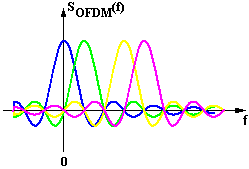Orthogonal frequency-division multiplexing facts for kids
Orthogonal Frequency Division Multiplexing is a technology related to Frequency Division Multiplexing. With it, many different signals can be sent over the same medium, at the same time. Each signal uses a different basis function. By using the basis function given, the sender and recipient will then see their signal better, the other signals will be clearly separated.
Advantages and disadvantages
Advantages
- Can adapt easily to bad channels (noisy,etc.)
- Robust against crosstalk between channels that are close together.
- Robust against Intersymbol interference (ISI) and fading caused by multipath propagation
- High spectral efficiency
- There are good implementations available
- Few problems with errors that come from time synchornization
- Tuned sub-channel receiver filters are not required (unlike conventional FDM)
- Facilitates Single Frequency Networks, i.e. transmitter macrodiversity.
Disadvantages
- Problems with Doppler shift.
- Synchronizing frequencies can be problematic
- Sensitive to frequency synchronization problems.
- High peak-to-average-power ratio (PAPR). This needs linear transmission circuits; they need a lot of power.
- Loss of efficiency caused by Cyclic prefix/Guard interval
Uses
Many technologies use OFDM. Among them are:
- ADSL and VDSL
- Power line communication
- Wireless LAN, namely 802.11a,g, and n, and HiperLAN/2 (802.11b uses Direct-sequence spread spectrum)
- 4G LTE mobile networks use OFDMA (OFDM multi-users variant)
- Some Digital radio systems
- Some Digital TV systems, most notably DVB-T
Images for kids
See also
 In Spanish: Multiplexación por división de frecuencias ortogonales para niños
In Spanish: Multiplexación por división de frecuencias ortogonales para niños

All content from Kiddle encyclopedia articles (including the article images and facts) can be freely used under Attribution-ShareAlike license, unless stated otherwise. Cite this article:
Orthogonal frequency-division multiplexing Facts for Kids. Kiddle Encyclopedia.


